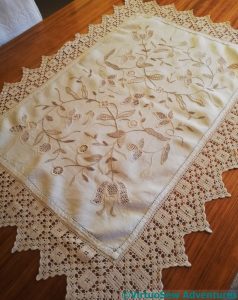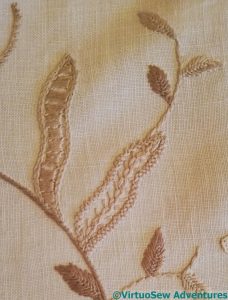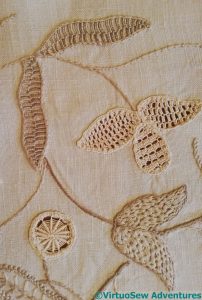A Source of Inspiration (1)
You might recognise some of the motifs on this teacloth..
Grandmama worked it, we think during the War, and it involves some motifs I used for the Coat of Many Colours.
In fact, even if I don’t use the exact motif, this teacloth, and a tablecloth (a sort of extended Director’s Cut!) are frequently the first places I look for inspiration when I am trying to put together a design for something stylised but floral. I suspect Grandmama would be laughing like a drain, as the family puts it, at the mere idea of being an inspiration all these years later!
I’ve also learned an even greater respect for textile and embroidery historians, examining and cataloguing design and stitch use over the years. It’s all too easy to assume, complacently, that one’s first assessment of a stitch was correct, and I learnt when I looked at this photo that I was definitely wrong about the second of these two leaves. It might be Wheatear, but I suspect I will have to look at the back to be sure.
And I’m far from convinced that Grandmama didn’t simply make up the other one as she went along. It’s a whipped or wrapped Something, but it looks like a more complex composite stitch to me…
Whipped Spiders Web Wheel as a needlelace stitch, a sort of floral motif of needlelace, and a pair of leaves in the top left that I thought for a moment should have been cut away. However, looking more closely (aren’t smartphone cameras really useful on occasion!), I see that the edging isn’t buttonhole, but chain, so, no.
And that pair of leaves in the bottom left? They’ve been puzzling me for a while. The stitch looks a little as though it’s a whipped or wrapped stitch. Maybe stem stitch worked over foundation stitches?




This is more varied than the tablecloth, I think. We will have to look! She crocheted the lace edging too. It used to grace the two tier trolley when we had “parson’s tea” in the sitting room on Sunday during the War (we lived in the kitchen mostly to conserve coal). I have it on my bedside table now. She did a lot of her embroidery and crochet sitting by the fire in the kitchen, listening to the radio, after we children had gone to bed. I expect it took her mind off what might be happening to Dad and her brothers.
Wow, that’s a real treasure Rachel! And the added story from your Mum is interesting too. Many of us keep our hands busy so we don’t end up going in circles in our heads.
How beautiful! The variation in stitches, the texture, and the gorgeous edging! A wonderful keepsake with memories stitched in.
Wow, it looks so beautiful, The texture is wonderful, and the border is so nice, Awsome embroidery
I do like this piece. I can see why you find it so inspiring.
How wonderful to have your grannies cloth! Such a source of inspiration.
Lovely to have the beautiful cloth with all its inspiration and your Mothers knowledge of its history. I have tray cloths we found after my Nana died by which time it was too late to find out if she had worked them herself and my Mother did not recognise them. xx
That’s lovely!
What a family heirloom! It must feel very meaningful to get inspiration from something someone you know made.
The two leaves at the bottom of the last picture, could they be a version of Portuguese Border Stitch? I have seen Indian embroidery where you make a horisontal ‘ladder’ over the shape of a leaf or petal, Then the thread is wrapped over two rungs of the ladder, then moved down one step, just like a Portuguese Border Stitch.
Fascinating puzzle and a beautiful cloth. What a clever Grandmama you had! The leaf filling with the two rows of loops overcast with blocks of straight stitches is a very common one for needlelace. Also the amount of braid stitch (cable plait stitch) around the leaves suggest that she might have had a reference book with Mountmellick stitches as well as lace stitches. I think the “not quite wheatear” stitch may be loop stitch or a slightly variant of it. It definitely isn’t wheatear or Mountmellick thorn stitch. Long armed feather is another possibility – with the proportions and slope adjusted to fit the shape.
Happy stitch-hunting, Sherlock!